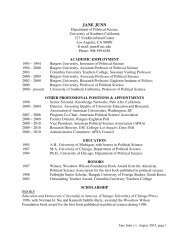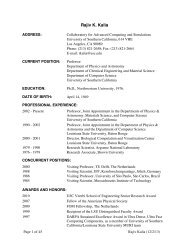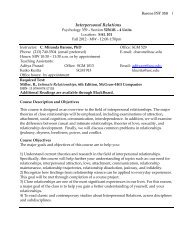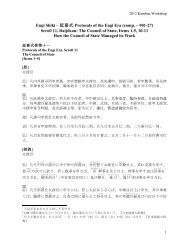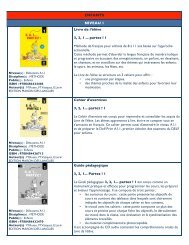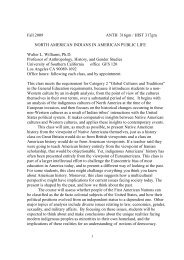Lispector symposium paper
Lispector symposium paper
Lispector symposium paper
You also want an ePaper? Increase the reach of your titles
YUMPU automatically turns print PDFs into web optimized ePapers that Google loves.
!<br />
Wo(man) Writing Self and Corporeal Other in Clarice <strong>Lispector</strong>’s<br />
A hora da estrela<br />
Clarice <strong>Lispector</strong>’s novella A hora da estrela emerged on a par with the cultural, social, and<br />
material transformations of modernization that occurred in Rio de Janeiro during the 1960’s and<br />
1970’s. As Philip Swanson argues, among these changes a raised political consciousness about<br />
social inequities in the U.S. and Europe expanded to Latin America and contributed to the<br />
literary “exhaustion of experimentalism…[and a] return to and engagement with human<br />
reality” (84) for the post-boom generation. In the specific case of Brazilian literature, this<br />
political call led many Brazilian writers to infuse their work with an illustration of the plights of<br />
Brazil’s most impoverished regions and people. Brazilian writers thus adopted a neo-realist<br />
narrative style that illustrated the human suffering of the inhabitants of Brazil’s most<br />
impoverished North-eastern region, or sertão (backlands). As countless North-easterners<br />
migrated to Rio de Janeiro looking for an escape from the drought that made their region<br />
uninhabitable, the North-easterner became the compelling subject of the new regionalist<br />
Brazilian novel. It is during this time of change that, as Sonia Roncandor noted, the near absence<br />
of social themes in Clarice <strong>Lispector</strong>’s fiction--prior to A hora da estrela--led various critics<br />
affiliated with the neo-realist movement to attack her novels.<br />
<strong>Lispector</strong>’s complex response to the criticism of her literary contemporaries is embedded in A<br />
hora da estrela, and will be one of the central inquiries of this <strong>paper</strong>. For <strong>Lispector</strong>, stepping into<br />
the role of “political writer” brought about intense self-questioning. As Roncador describes,<br />
<strong>Lispector</strong>, unlike many of her male neo-realist contemporaries, questioned “the literary authority
to speak of, and for, the poor,” since “for her, the author is not necessarily a privileged interpreter<br />
of social reality, and literature, in turn, is not always a special site of revelation of this<br />
reality” (22). In A hora da estrela, <strong>Lispector</strong>’s narrative problematizes the writer’s imaginary<br />
appropriation of the marginalized other in fiction through an interrogation of the nature of<br />
aesthetic mimesis itself. As the male narrator, Rodrigo S.M. Relato, of A hora da estrela makes<br />
clear the beautification of poverty through a romantic narrative that idealizes the marginal<br />
becomes suspect in leaving structures of oppression intact and, also, in replacing the reality of<br />
the marginal subject with the idealized and narcissistic fantasy of the author. Moreover, in A hora<br />
the collusion of a virtual reader directly addressed throughout the novel, who perversely enjoys<br />
reading about the pain of the North-eastern girl the male narrator Rodrigo S.M. invents, also<br />
comes under scrutiny in <strong>Lispector</strong>’s novella.<br />
The perverse pleasure of reading about the suffering of a marginal character is a complex<br />
aspect of the problem of mimesis that Timothy Murray discusses in his introduction to Mimesis,<br />
Masochism and Mime. According to Murray, the earliest reflections on aesthetic mimesis have<br />
pondered the paradox of the pleasure the spectators derive from aesthetically experiencing the<br />
physical and psychic suffering of invented fictional characters (14). Aristotle, one of the first<br />
Western philosophers to ponder this aesthetic paradox, put it way: “though the objects<br />
themselves may be painful to see, we delight to view the most realistic representations of them in<br />
art” (quoted in Murray14). In my view, it is precisely this paradoxical aspect of aesthetic<br />
consumption that <strong>Lispector</strong> is centrally interested in exploring in A hora da estrela. Crucially<br />
Rodrigo S.M.--the fictional male writer and narrator of A hora--often confronts the reader with<br />
his or her pleasure in reading about the misfortunes of the girl he invents, and questions the<br />
2
ethics of that pleasure. Furthermore, the pleasure of the reader often parallels Rodrigo’s writerly<br />
pleasure in inventing the North-east girl’s misfortunes. The virtual reader included in A hora is<br />
therefore challenged to question the ethics of both her pleasure in reading about the suffering of a<br />
fictional North-east girl as well as the ethics of the male writer’s pleasure in appropriating the<br />
figure of the marginalized other to invent his fictional narrative. 1<br />
<strong>Lispector</strong>’s narrative, emphasizing the masochist pleasures the virtual reader and fictional<br />
writer Rodrigo S.M. take from the narrative of a female protagonist’s suffering in A hora da<br />
estrela brings to the forefront what Murray claims is “the ambivalent pathos evoked by the<br />
divisions of mimesis and their profound turn of subject and socius against themselves, [or ] the<br />
theatricalization of masochism” (14). Rodrigo S.M., in playing the role of “moral masochist”<br />
writer in A hora da estrela, puts his ambivalence and self-reflexivity on display for a necessary<br />
external audience (the virtual reader) he addressed. By extension, his female invention, the<br />
North-eastern girl Macabea, becomes his “master tableau” (Murray 18).<br />
The mise-en-scène of the initial encounter between Rodrigo S.M. and the real life North-east<br />
girl that serves as the real-life model for Macabea occurs in Rio de Janeiro. At the beginning of A<br />
hora, Rodrigo tells the reader that he has been given the moral responsibility to write about the<br />
life of a North-eastern girl he saw on the streets of Rio de Janeiro. Rodrigo takes the role of<br />
“moral masochist” by promising to indict in his narrative the class, cultural, and social<br />
asymmetries of contemporary Rio de Janeiro. As part of his performative moral discourse, he<br />
also gives the reader the moral reasons why he feels compelled to write about the North-east girl:<br />
1 <strong>Lispector</strong> allows no one in A hora da estrela’s narrative—author, narrator, or reader—to claim innocence without<br />
being confronted with the disingenuousness of that claim. So long as the image of the marginal is appropriated by<br />
bourgeois writers and turned into a commodity that bourgeois readers consume--while the actual North-easterners’<br />
oppressive circumstances are left intact--neither readers nor writers can claim innocence.<br />
3
Como a nordestina, há milhares de moças espalhadas por cortiços, vagas de cama num<br />
quarto, atrás de balcões trabalhando até a estafa. Não notam sequer que são facilmente<br />
substituíveis e que tanto existiriam como não existieriam. Poucas se queixam e ao que eu<br />
saiba nenhuma reclama por não saber a quem 2 (<strong>Lispector</strong> 17).<br />
Rodrigo’s social commentary theatrically performs a moral indictment of the indifference the rest<br />
of the world, and in particular Rio de Janeiro’s affluent population, have in relation to the<br />
thousands of anonymous North-eastern girls that work in the city. Thoroughly disempowered by<br />
the capitalist system that exploits their labor and simultaneously dehumanizes them, the girls<br />
cannot protest because, as Rodrigo asserts, they have no audience. Rodrigo’s grand moral<br />
gesture is transformed in the duty of enunciating the protest that these disempowered North-<br />
eastern girls cannot utter in their everyday lives through his act of writing about the everyday life<br />
of one of them. States Rodrigo: “O que escrevo é mais do que invenção, é minha obrigação<br />
contar sobre essa moça entre milhares delas” 3 (<strong>Lispector</strong> 15). He adds, “E dever meu, nem que<br />
seja de pouca arte, o de revelar-lhe a vida” 4 (<strong>Lispector</strong> 15).<br />
Rodrigo’s two “duties” become the two performative elements that constitute the<br />
narrative of Macabea: first, he needs to make the North-eastern girl visible to the bourgeois<br />
readers; second, he paradoxically needs to reveal to the North-eastern girl of his invention her<br />
own existence. These two goals translate into providing the reader with the mise-en-scène (i.e.,<br />
the general background of the North-east girl’s circumstances in Alagoas and in Rio de Janeiro),<br />
and to delve into Macabea’s inner life (including her thoughts, impressions, and feelings) as well<br />
2 There are thousands of girls like this girl from the North-east to be found in the slums of Rio de Janeiro, living in<br />
bedsitters or toiling behind the counters for all they are worth. They aren’t even aware of the fact that they are<br />
superfluous and that nobody cares a damn about their existence. Few of them ever complain and as far as I know<br />
they never protest, for there is no one to listen. (<strong>Lispector</strong> 1986, 14)<br />
3 “It is my duty to relate everything about this girl among thousands of others like her” (<strong>Lispector</strong> 1986, 13).<br />
4 “It is my duty, however unrewarding, to confront her with her own existence. For one has the right to<br />
shout” (<strong>Lispector</strong> 1986, 13).<br />
4
as describe her reactions to the external world (including her reaction to various external and<br />
internal stimuli). Rodrigo begins his narrative of the North-eastern girl by sketching the<br />
important details about Macabea’s unique physical and psychic characteristics. He tells the<br />
reader that in contrast to other North-eastern girls who sell their bodies for food, the girl he will<br />
write about “falarei mal tem corpo para vender” (scarcely has a body to sell), adding that<br />
“ninguém a quer; ela é virgem e inócua, não faz falta a ninguém” (nobody desires her, she is a<br />
harmless virgin whom nobody needs) (<strong>Lispector</strong> 16).<br />
The fact that Macabea is such an undesirable woman makes Rodrigo’s self-ascribed<br />
moral duty to write about her--by identifying or playing her--come into constant conflict with the<br />
feelings of disgust and aesthetic rejection she often provokes in him. However Rodrigo finds that<br />
as he invents the North-eastern girl through the masochistic self-effacement of his subjectivity,<br />
his hatred and disgust is also capable of being transformed into the affect of love for his aesthetic<br />
re-production--especially as in the moments when she appears to reveal a lyrical life of her own.<br />
More surprisingly, through the masochist surrender of his subjectivity Rodrigo also discovers<br />
that the girl’s body and mind offers respite from his own existentialist malaise: a condition he<br />
associates explicitly with the alienation his self suffers by virtue of being a member of modern<br />
culture.<br />
In Rodrigo’s ongoing process of invention through masochistic identification, his<br />
insistence in capturing the “essence of this girl”--making her more real than reality (which<br />
exceeds him)--is fraught with his first-person irruptions and the reterritorializations of his<br />
subjectivity over the story of the other he is creating, which serve to temporarily efface the<br />
appearance of the North-east girl. Rodrigo’s irruptions and reterritorializations over the narrative<br />
5
stem from Macabea’s radical otherness from his own gender, social class, education, and general<br />
experience of everyday life. Additionally, Rodrigo’s identification with the North-east girl also<br />
produces peculiar physical effects and a certain level of paranoia. Examples include the<br />
experience of a toothache that Rodrigo tells the reader accompanies the whole narrative, and the<br />
paranoid sensation that the North-eastern girl threatens to choke him if he doesn’t write her story.<br />
Yet Rodrigo also appears to understand that these various and often unpleasant physical<br />
sensations are side-effects of his masochistic identification with the girl that open him up to the<br />
possibility of re-producing another in his writing. Rodrigo’s sensation of becoming a receptive<br />
vessel, however, is not felt without his ambivalence and resistance. He submits to writing about<br />
the North-eastern girl, but often views her as an alien and feminizing virus whose invasion he<br />
must physically and psychically tolerate in order to write her story, even as he at times both fears<br />
and loathes this contamination. As Walter Bruno Berg describes, ultimately the relationship<br />
between Rodrigo and Macabea proves to be mutually influential and contaminating: “El<br />
encuentro entre el narrador y la protagonista significa que éste le comunica a Macabea su<br />
conciencia y ella le comunica a él su felicidad de ‘pessoa inteirea’, es decir su inconciencia’” 5<br />
(115). Yet the wholeness, plenitude, and beatitude that Macabea is able to transmit to Rodrigo<br />
through his masochistic surrender of self is undone when he resumes his authorial subjectivity<br />
(becoming self-conscious again). Once this authorial subjectivity is restored, Rodrigo S.M. takes<br />
pleasure in inventing victimizers and victimizing situations for Macabea. But as Marta Peixoto<br />
observes, there is a curious side-effect to Rodrigo’s inventions, which is that the North-eastern<br />
girl “drags him through the misfortunes he invents for her” (93). Thus by making use of his<br />
5 “The encounter between the narrator and the protagonist means that he communicates his conscience to Macabea<br />
and she communicates her happiness, of whole person, to him, that is to say, her unconsciousness.” [my translation]<br />
6
sadistic (read sexist, racist, and classist) imagination, but not surrendering his desire to play her<br />
role, Rodrigo also becomes the masochistic victim of his own sadistic imagination.<br />
When Rodrigo infuses his sadism into the narrative, according to Peixoto, the “language<br />
of the grotesque...fixes Macabea’s life and appearance in cruelly degrading poses” (93).<br />
However, Peixoto also notes that Rodrigo often switches stylistic gears and mobilizes a different<br />
lyrical language that restores Macabea’s paradoxical beatitude (93). These lyrical re-writings<br />
favor moments in which Macabea is absorbed in the activities of aesthetic contemplation. These<br />
moments of aesthetic contemplation, which envelop Macabea in an experience of aura, provide<br />
the reader with the most intimate dimensions of her subjectivity. In particular, Macabea’s<br />
aesthetic experience of aura by listening to the song Una lacrima furtiva on the radio is a<br />
compelling example, which simultaneously refutes Walter Benjamin’s argument that aura is<br />
diminished by reproducible technologies. Rather, Macabea’s listening experience of aura through<br />
the radio lends support to Jim Collins’ argument that during and after the age of mechanical<br />
reproducibility, “aura becomes a matter of personal projection and appropriation that ironically<br />
cannot be realized without technological mediation and exists as one tactic beside many others<br />
that make use of cultural material” (98-9).Worth emphasizing here is that Macabea’s act of<br />
listening is one of the key ways in which Peixoto’s characterization of Macabea’s subjectivity is<br />
illustrated: “[Macabea] is a quintessentially vulnerable being, ideally open to existence...she<br />
possesses, like a holy fool, an unsought, unconscious wisdom” (Peixoto 96).<br />
Accordingly Macabea’s openness to the world is demonstrated by her auditory experience<br />
of the Italian soprano Caruso’ voice, singing Una Lacrima Furtiva, that she listens to on the<br />
radio. Rodrigo asserts: “‘Una Furtiva Lacrima’ for a única coisa belíssima na sua<br />
7
vida” (<strong>Lispector</strong> 55) [“Una Lacrima Furtiva had been the only really beautiful thing in<br />
Macabea’s life” (<strong>Lispector</strong> 1986, 50)]. Macabea’s affective connection to Caruso’s voice makes<br />
her experience what Hélène Cixous’s reading defines as jouissance: an experience of the painful<br />
pleasure of “desiring” that Caruso’s voice affectively transmits to Macabea.<br />
The after-effect of Macabea’s experience of the “aura” of Caruso’s voice is that she feels<br />
moved to re-produce this moment aesthetically. This desire thus shifts Macabea’s positionality<br />
from aesthetic object to desiring subject. However, Macabea’s desire to mimetically re-produce<br />
the aesthetic beauty of Caruso’s voice, in order to externalize her own experience of the painful<br />
flow of desire passing through her body, is an impossible feat for her to actualize. Instead, what<br />
the virtual reader of A hora is presented with is the tragedy, or pathos, of Macabea’s failed<br />
attempt to approximate this aura with her own frail voice. The way in which Rodrigo describes<br />
Macabea at the conclusion of A hora, as a “little more than a music box sadly out of<br />
tune” (<strong>Lispector</strong> 86), lyrically conjures the pathos of that failed desire, particularly when she<br />
weeps because her “voz era crua e tão desafinada como ela mesma era” (<strong>Lispector</strong> 55) [“voice is<br />
as tuneless and rough as the rest of her body” (<strong>Lispector</strong> 50)]. Yet Macabea’s experience of aura<br />
through the voice of Caruso is ultimately also a mirror of the aura that surrounds Macabea, as an<br />
affective aesthetic re-production that attempts to capture the other’s singularity.<br />
By extension, further consumptive activities Macabea engages in, like watching horror<br />
films or misidentifying with female movie stars, reveal Macabea as a female consumer with<br />
certain sadomasochist desires connected to the erasure of her social (read racial and class)<br />
markers. Though these racial and social markers are not consciously observed by Macabea as<br />
being the reasons for her subjection and/or marginalization, <strong>Lispector</strong>’s narrative makes these<br />
8
implications clear. One essential way in which <strong>Lispector</strong> illustrates this violence is the radical<br />
moments of alterity Macabea suffers in front of mirrors. The confrontation of her image in the<br />
mirror is an important way in which her racial and class identity is grotesquely othered. In one<br />
such episode in front of the mirror, Rodrigo’s description of Macabea’s face connotes racist<br />
undertones. Macabea observes that in the mirror her nose has suddenly “tornado enorme como o<br />
de um palhaço de nariz de papelão” 6 (<strong>Lispector</strong> 28). A moment later Macabea, seemingly very<br />
out of character, muses about her mirror image: “tão jovem e já com ferrugem” (<strong>Lispector</strong> 28)<br />
[“so young and yet so tarnished” (<strong>Lispector</strong> 1986, 25)]. 7<br />
In later confrontations of Macabea with her mirror image, Rodrigo will implicitly<br />
continue to other her racial facial features, which will be aesthetically judged according to how<br />
different they are from the European ideals proliferated by consumer culture’s visual media<br />
within Rio de Janeiro. This claim is supported by Feracho, who argues that Macabea’s<br />
“Otherness is further expressed by Rodrigo’s at times detailed descriptions of her overall facial<br />
features” (95). In particular, Feracho notes that Rodrigo’s most extensive description of<br />
Macabea’s physical features makes her aesthetic racial inferiority in relation to whiteness clear:<br />
Vi ainda dois olhos enormes, redondos, saltados e interrogativos…No espelho<br />
distraídamente examinou de perto as manchas no rostro. Em Alagos chamavan-se de<br />
‘panos’, diziam que vinham do fígado. Disfarçava os panos com grossa camada de pó<br />
branco e se ficava meio caiada era melhor que o pardacento 8 (<strong>Lispector</strong> 30).<br />
6 “grown as huge as those false noses made out of <strong>paper</strong> mâché donned by circus clowns” (<strong>Lispector</strong> 1986, 24).<br />
7 In my view, it is Rodrigo’s bourgeois point of view, making an aesthetic judgment of Macabea’s appearance, that<br />
comes through in this comment.<br />
8 “Her eyes were enormous, round, bulging, and inquisitive…Lost in thought, [Macabea] examined the blotches on<br />
her face in the mirror. In Alagoas, they had a special name for this condition—it was commonly believed to be<br />
caused by the liver. The girl concealed her blotches with a thick layer of white powder which gave the impression<br />
that she had been whitewashed but it was preferable to looking sallow” (<strong>Lispector</strong> 1986, 26-27).<br />
9
As Feracho observes, in this reference “Rodrigo S. M. links Macabea’s physical defects to a<br />
physical deficiency. Not only is her face tainted, but so is her body” (95). In Feracho’s view<br />
Macabea’s use of the face powder is an attempt “to erase or at least conceal her otherness with a<br />
literal and figurative ‘whiteness’” since “her sallow complexion—and consequently her<br />
racialized identity—can never be erased” (95). Thus despite Macabea’s attempt to conceal the<br />
racial and social markers of her complexion and skin tone through her use of whitening powder,<br />
Rodrigo’s cruel portraits of Macabea—as ugly, sexually undesirable, racially inferior, unclean,<br />
etc.—are characteristics that enhance her invisibility as a potential object of male desire due to<br />
her racial otherness. Feracho thus concludes, “Macabea’s sallow, nonwhite skin, in the narrator’s<br />
view, is representative of her condition as outsider—someone seemingly dead (bloodless) and<br />
not a ‘real’, ‘beautiful’ woman” (94).<br />
Ironically, Macabea’s exclusion from the white ideal of female beauty does not prevent<br />
her from being a female consumer with a deep investment in the advertisements that transmit this<br />
message. Macabea indulges in collecting advertisements and daydreaming about the fantasies<br />
they produce for her: “Nas frígidas noites, ela, toda estremecente sob o lençol de brim,<br />
costumava ler à luz de vela os anúncios que recortava dos jornais velhos do escritório” 9<br />
<strong>Lispector</strong> 42). Yet as we shall see the positionality that Macabea occupies, as a deeply<br />
impoverished and thereby limited consumer, adds a peculiar spin to the fantasies that these<br />
advertisements trigger. As the following case demonstrates, her pleasurable visual consumption<br />
of the collected advertisements is intertwined with her very real physical need for nourishment,<br />
and leads to her dream of consuming one of the luxury objects advertised:<br />
9 “On wintry nights, shivering from head to foot under a thin cotton sheet, she would read by candle-light the<br />
advertisements that she had cut out of old news<strong>paper</strong>s lying around the office” (<strong>Lispector</strong> 1986, 38).<br />
10
Havia um anúncio, o mais precioso, que mostrava em cores o pote aberto de um creme<br />
para pele de mulheres que simplesmente não eran ella. Executando o fatal cacoete que<br />
pegara de piscar os olhos … o creme era tão apetitoso que se tivesse dinheiro para<br />
comprá-lo não seria boba. Que pele, que nada, ela o comeria, isso sim, às colheradas no<br />
pote mesmo 10 (<strong>Lispector</strong> 42).<br />
Macabea’s emaciated body literally craves nourishment that the rich luxuriousness of the cream<br />
evokes. The asymmetry of a consumerist system which advertises expensive luxuries to<br />
bourgeois white women but also to lower class woman like Macabea who cannot afford the<br />
essentials makes Macabea’s fantasy both perversely humorous and poignant. Macabea, who is<br />
terribly undernourished, imagines possessing the rich and luxurious cream not to apply for her<br />
face and better her skin, but to eat and put an end to the pangs of hunger that torment her.<br />
But beyond the specifics of her body’s literal hunger for food, Macabea’s pleasure in<br />
desiring unattainable commodities speaks to a more general masochistic consumer desire, or<br />
pleasure, in desiring the unattainable. Rodrigo describes that “Vez por poutra ia para a Zona Sul e<br />
ficava olhando as vitrinas faiscantes de jóias e roupas acetinadas—só para se mortificar um<br />
poco” 11 (<strong>Lispector</strong> 38). The truth, Rodrigo adds, “é que ela sentia falta de encontrar-se consigo<br />
mesma e sofrer um pouco é um encontro” 12 (<strong>Lispector</strong> 38). The neurotic and mortifying activity<br />
of window shopping, according to Rodrigo, enables Macabea to find herself again. It becomes a<br />
kind of therapy Rodrigo compares to having “crutches,” which provide a temporary escape from<br />
the daily shocks and stresses of modern everyday life.<br />
10 The advertisement she treasured most of all was in colour: it advertised a face cream for common with<br />
complexions so very different than her own sallow skin…The cream looked so appetizing that, were she to find<br />
enough money to buy it, she wouldn’t be foolish. Never mind her skin! She would eat the cream, she would, in large<br />
spoonfuls straight from the jar (<strong>Lispector</strong> 1986, 38).<br />
11 “occasionally she wandered into the more fashionable quarters of the city and stood gazing at the shop windows<br />
displaying glittering jewels and luxurious garments in satin and silk—just to mortify the senses” (<strong>Lispector</strong> 1986,<br />
34).<br />
12 “is that she needed to find herself and a little mortification helped” (<strong>Lispector</strong> 1986, 44)]<br />
11
In complement to Macabea’s desire for various commodity objects, one day a young<br />
North-easterner like herself named Olimpico approaches her, and her sensual desire is instantly<br />
triggered. Describes Rodrigo: “E a moça, bastou-lhe vê-lo para torná-lo imediatamente sua<br />
goiaba-com-queijo” 13 (<strong>Lispector</strong> 47). Macabea’s internal transformation of Olimpico into her<br />
favorite and most cherished sweet is significant. Her female gaze, in looking at Olimpico,<br />
transforms him into a food with the implicit potential to feed her body’s sensual desires.<br />
Importantly, Macabea’s and Rodrigo’s encounter also adds the second person to the alternating<br />
first and third person voices already in play up until this point. 14 In this dialogic exchange in<br />
which Macabea and Olimpico are able to speak without Rodrigo’s first person mediation or<br />
omniscient third person psychological readings of Macabea, <strong>Lispector</strong> deploys a stylistic element<br />
more commonly used in theatre and cinema. Reading like a fluid script between two actors,<br />
Olimpico and Macabea can be seen as putting on a performance for the virtual reader.<br />
On this first encounter, Olimpico has difficulty pronouncing the girl’s strange and<br />
unheard of name, and concludes “Me desculpe mas até parece, doença de pele”(<strong>Lispector</strong> 47)<br />
[“Gosh, it sounds like the name of a disease… a skin disease” (<strong>Lispector</strong> 1986, 43)] a comment<br />
that echoes Rodrigo’s own comment that the girl had clung to his skin “qual melado pegajoso ou<br />
lama negra” (<strong>Lispector</strong> 24) [“like some viscous glue, or contaminating mud” (<strong>Lispector</strong> 1986,<br />
21)]. Not surprisingly, the relationship between Macabea and Olimpico does not bode well when<br />
13 “The girl only had to see the youth in order to transform him immediately into her guava preserve with<br />
cheese” (<strong>Lispector</strong> 1986, 42).<br />
14 As Earl E. Fitz breaks down: “[on a structural level] there is a fluctuation between the first-person, either that of<br />
our struggling narrator or that of one of the characters most involved; second person which is generally reserved for<br />
the illuminating and often funny exchanges of dialogue between characters but which is also used by the narrator in<br />
direct discourse with the reader; and third person, the omniscient, traditional mode of story-telling and one with<br />
which Clarice <strong>Lispector</strong> has been able to produce a very telling kind of psychological realism” (199).<br />
12
Macabea’s name produces such an undesirable connotation for Olimpico, or when his brutal<br />
honesty replicates the cruel undertones Rodrigo’s authorative prose takes in describing Macabea<br />
as an undesirable social victim.<br />
Olimpico and Macabea meet a couple more times in different spaces of Rio de Janeiro<br />
free to the public, but eventually Olimpico tires of the bottomless curiosity she manifests in<br />
sharing the pieces of knowledge she hears from “Clock Radio” and his own inability to explain<br />
or understand the information she provides. Too often, Macabea asks Olimpico about the words<br />
she hears on “Clock Radio” that fascinate her but that she cannot understand: que quer dizer<br />
‘élgebra’? … que quer dizer cultura? … que quer dizer rua Conde de Bonfim? ... que é conde? 15<br />
(<strong>Lispector</strong> 54-55). These questions irritate and anger Olimpico because they, and by extension<br />
Macabea, confront him with his own ignorance. The two North-easterners dialogic exchange<br />
thus continuously fails, vexed as it is by Macabea’s insatiable curiosity and Olimpico’s inability<br />
to answer any of her questions.<br />
The theme of whiteness as the privileged racial category of feminine beauty in Brazil,<br />
despite the majority numbers of non-white Brazilians, is also given further elaboration in<br />
Macabea’s relationship with Olimpico. After confiding in Olimpico her desire to become a movie<br />
star like Marilyn Monroe, Olimpico scoffs at Macabea’s dream, pointing out her racial otherness<br />
as one marker that makes this dream absurd. Macabea first asks Olimpico if he knows that<br />
Marilyn “era toda cor-de-rosa?” (<strong>Lispector</strong> 58) [“Marilyn Monroe was the color of<br />
peaches?” (<strong>Lispector</strong> 1986, 53)]. Olimpico, with his by now customary cruelty, retorts: “E você<br />
tem cor de suja. Nem tem rosto nem corpo para ser artista de cinema” (<strong>Lispector</strong> 58) [“And you<br />
15 “What does elgebra mean? . . . What does electronic mean? . . . What does culture mean? . . . What does Count of<br />
Bonfim Street mean? . . . What is a Count?” (<strong>Lispector</strong> 1986, 49-50).<br />
13
are the color of mud. What makes you think that you’ve got the face or the body to become a<br />
film star?” (<strong>Lispector</strong>1986, 53)]. Here another contrast of skin color, the peach-colored skin of<br />
Marilyn Monroe versus the mud-colored skin of Macabea, reinforces another way in which<br />
Macabea’s coloring becomes the antithesis to the pre-fabricated Hollywood ideals of white<br />
actresses like Monroe: white feminine ideals disseminated to Latin American cities like Rio at<br />
this time through films, posters, and other kitsch reproductions and paraphernalia.<br />
Yet Macabea persists in her desire to transform her own face and body into the likeness of<br />
Marilyn Monroe. She stands in front of the washroom mirror and puts on a new red lipstick she<br />
buys in the hopes that it will magically approximate her image to the image of Monroe (the<br />
magic of transformation so many lipstick advertisements promise):<br />
No banheiro da firma pintou a boca toda e até fora dos contornos para que os seus lábios<br />
finos tivessem aquela coisa esquisita dos lábios de Marylin Monroe. Depois de pintada<br />
ficou olhando no espelho a figura que por sua vez a olhava espantada. Pois em vez de<br />
batom parecía que grosso sangue lhe tivesse brotado dos lábios por um soco em plena<br />
boca, com quebra-dentes e rasga-carne 16 (<strong>Lispector</strong> 67).<br />
As can be observed, the washroom mirror once more becomes the site of alterity and violence<br />
done to her image. If Macabea does not surrender her desire to look like Monroe after this<br />
violent episode, it is because what obsesses Macabea with the image of Monroe is her desire to<br />
be the female object of male sexual desire that Monroe epitomizes. Macabea imagines that<br />
through the magical transformation of her face/body into Monroe’s likeness she will become a<br />
visible object of desire by the male gaze. It is through this persistent fantasy that Macabea tries to<br />
16 “she painted her lips lavishly beyond their natural outline, in the hope that she might achieve that stunning effect<br />
seen on the lips of Marilyn Monroe. When she had finished she stood staring at herself in the mirror, at a face which<br />
stared back in astonishment. The thick lipstick looked like blood spurting from a nasty gash, as if someone had<br />
punched her on the mouth and broken her front teeth” (<strong>Lispector</strong> 1986, 62).<br />
14
ecuperate the sexual vitality that her body has been robbed of by what Peixoto describes as<br />
“patriarchy’s neutralization of [Macabea’s] sensuality” (90).<br />
By contrast, Macabea’s love for horror films is informed by the sadomasochist pleasure<br />
that such a genre and medium affords her. Rodrigo informs the reader that Macabea: “Tinha<br />
predilecção por mulher enforcada ou que levava um tiro no coração” 17 (<strong>Lispector</strong> 63). In<br />
contradistinction to Peixoto’s take on this moment as another instance of the “psychic rape” of<br />
Macabea by dominant social forces, I see this moment of Macabea’s visual pleasure in watching<br />
the cinematic spectacle of death violently “taking” the body of woman both as a sadomasochistic<br />
sensual fantasy of female spectators like Macabea. Further supporting the association of<br />
Macabea’s female desire for sensual death, Tace Hedrick observes that “Macabea’s sex is the<br />
mark, literally, of her being, her existence. This sensuality is connected explicitly to death” (52).<br />
Indeed, Hedrick reveals another surprising element between Macabea’s attraction to Monroe,<br />
when she states “her dream is to be a movie star like the suicide Marilyn Monroe, with pink skin<br />
(65)”(52) [my emphasis]. Hedrick’s interpretation makes Rodrigo’s following statement, after his<br />
description of Macabea’s love for horror films, acquire more clarity: “Não sabia que ela própia<br />
era uma suicida embora lhe tivesse ocorrido se matar” 18 (<strong>Lispector</strong> 64).<br />
Taking Macabea’s sadomasochistic fantasy and identification with the women being<br />
killed in horror films into consideration, it is not surprising that she also identifies with a poster<br />
of the young Greta Garbo hanging over her boss’ office. Even though Garbo, the divine face of<br />
silent cinema, like Monroe, the immortalized female sex symbol, are both disjunctive<br />
17 “Macabea had a passion for horror films.She especially liked films where the women were hanged or shot through<br />
the heart with a bullet” (<strong>Lispector</strong> 1986, 58).<br />
18 “It never dawned on her that she was a suicide case even though she had never contemplated killing<br />
herself” (<strong>Lispector</strong> 1986, 58).<br />
15
identifications when one compares Macabea’s appearance with their extraordinary and privileged<br />
white beauty, together Monroe and Garbo emphasize the uncanny quality of the cinematic image<br />
to produce aura. 19 It is significant therefore that the identification of Macabea with Garbo frames<br />
Macabea’s final moment of death and clarifies the explicit connection Rodrigo makes of this<br />
death to cinema: “Assim como ninguém lhe ensinaria um dia a morrer: na certa morreria um dia<br />
como se antes tivesse estudado de cor a representação do papel de estrela. Pois na hora da morte<br />
a pessoa se torna brilhante estrela de cinema, é o instante de glória de cada um e é quando como<br />
no canto coral se ouvem agudos sibilants” 20 (<strong>Lispector</strong> 32). Contextualizing the meaning of<br />
Garbo’s aura, Roland Barthes’ states that Garbo’s face belonged to a moment in cinema before<br />
the war where<br />
capturing the human face was able to plunge audiences into the deepest ecstasy, when<br />
one literally lost oneself in a human image as one would in a philtre, when a face<br />
represented a kind of absolute state of the flesh, which could be neither reached nor<br />
renounced. (56) (my emphasis)<br />
By stark contrast, in1970’s Rio de Janeiro Gloria (Macabea’s co-worker) asks Macabea: “Oh<br />
mulher, não tens cara? (<strong>Lispector</strong> 70) [“Hey girl, haven’t you any face?” (<strong>Lispector</strong> 1986, 65)].<br />
And Olimpico also lectures Macabea on how the message her face sends to the world is<br />
unacceptable: “A cara é mais importante do que o corpo porque a cara mostra a pessoa está<br />
sentindo. Você tem cara de quem comeu e não gostou, não aprecio cara triste, vê se muda de<br />
19 <strong>Lispector</strong>’s use of autobiography, which has countless echoes of her own life throughout her novella, including<br />
her own infancy spent growing in the North-east (which Rodrigo claims as his own experience), her job as a ghost<br />
writer for face cream advertisements, her own love of horror films, her marriage to an ambitious diplomat, sets up<br />
the model for her use of autobiographical information of both Monroe and Garbo that connects with Macabea.<br />
20 “No one would teach her how to die one day: yet one she would surely die as if she had already learned by heart<br />
how to play the starring role. For at the hour of death you become a celebrated film star” (<strong>Lispector</strong> 1986, 26).<br />
16
‘expressão’” 21 (<strong>Lispector</strong> 57). If as Walter Bruno Berg argues, Macabea initially functions as a<br />
“calcomanía de ese sinnumero de mujeres—y de hombres, por supuesto—sin cáracter y sin cara<br />
que produce la sociedad moderna” 22 (113), what <strong>Lispector</strong> illustrates in A hora da estrela’s<br />
conclusion is that in dying Macabea can recuperate the singularity of her face, which she along<br />
with other consumers has lost in modern society. Like the face of Garbo--which was able to<br />
transmit to the spectator the experience of what Barthes’ refers to as “deepest ecstasy” (56) in<br />
watching her face’s transfiguration 23 into the divine--<strong>Lispector</strong> attempts to do give a parallel<br />
experience for the readers “watching” Macabea’s death.<br />
Significantly, Barthes’s observation that the face of Garbo “still partakes of the same rule<br />
of Courtly Love, where the flesh gives rise to mystical feelings of perdition” (56) connects to the<br />
perdition Rodrigo phantasmatically claims to have captured on the face of the North-eastern girl<br />
he inadvertently saw on the streets of Rio de Janeiro, compelling him to give that anonymous<br />
and invisible face a singularity that produced an experience of aura for the reader. <strong>Lispector</strong>’s<br />
literary re-production of an actual North-east girl the writer Rodrigo caught a glimpse of in the<br />
streets of Rio de Janeiro thus mimics the cinematic medium’s spectatorial desire “to get a hold of<br />
an object at very close range by way of its likeness, its reproduction” (qtd. in Murray 96) . But it<br />
in Garbo’s at once sensuous and mystical evocation of death through her face that we find the<br />
ultimate metaphorical connection that ties her to Macabea’s tragic death and to the title of the<br />
novella: “the hour of the star”. Accordingly Macabea’s body, like Garbo’s face, in her final<br />
21 “A person’s face is the most important thing because the face betrays what a person is thinking: your face is that<br />
of somebody who has just tasted a sour apple. Stop looking so mournful…he said: try to change your<br />
demeanour” (<strong>Lispector</strong> 1986, 52).<br />
22 “a stick-on image (like a tattoo), of the countless women—and men, of course—without a character or a face that<br />
modern society produces.” [my translation]<br />
23 Some of the exemplary films in this category are The Temptress, Camille, and Matahari.<br />
17
moment of perdition obtains its most terrifying sexual climax: as death sensuously advances over<br />
her virgin body and deflowers it, “revealing Macabea to herself” in the climatic moment of her<br />
surrender to death’s seduction.<br />
With A hora da estrela Clarice <strong>Lispector</strong> provides Latin Americanists with a fascinating<br />
example of how a Brazilian woman writer, writing from the so called periphery of the<br />
technological and cosmopolitan European and U.S. centers, attested to the continuous presence<br />
of aura in the aesthetic products of technologically reproduced media and attempted to re-<br />
produce that aura in literature. In order to accomplish this feat, <strong>Lispector</strong> summoned different<br />
moments in which Macabea, as spectator, experienced “aura” through her perception of different<br />
aesthetic ephemera taken from high and low culture--Caruso’s song, different cultural fragments<br />
of Clock radio, the sex image of Marilyn Monroe, the poster of Greta Garbo, and horror films--<br />
that provided aesthetic objects of identification that simultaneously mirrored Macabea’s desire:<br />
an uncanny desire for an intimate encounter of her female body with death.<br />
18
Works Cited<br />
Alonso, Carlos J. The Burden of Modernity. New York: Oxford University Press, 1998.<br />
Barthes, Roland. Mythologies. Trans. Annette Lavers. New York: Hill and Wang, 1999.<br />
Benjamin, Walter. Illuminations. Trans. Harry Zorn. Ed. Hannah Arendt. London: Pimlico, 1999.<br />
Berg, Walter B. "Otredad y escritura femenina en algunas obras de autoras latinoamericanas."<br />
Iberomania 41 (1995): 102-114.<br />
Cixous, Hélène. Reading with Clarice <strong>Lispector</strong>. Minneapolis: University of Minnesota Press,<br />
1990.<br />
Collins, Jim. Architectures of Excess. New York: Routledge, 1995.<br />
Felski, Rita. The Gender of Modernity. Cambridge: Harvard University Press, 1995.<br />
Feracho, Lesley. Linking the Americas. New York: State University of New York Press, 2005.<br />
Fitz, Earl E. Sexuality and Being in the Postructuralist Universe of Clarice <strong>Lispector</strong>. Austin:<br />
University of Texas Press, 2001.<br />
Hedrick, Tace. "Mother, Blessed Be You Among Cockroaches: Essentialism, Fecundity, and<br />
Death in Clarice <strong>Lispector</strong>." Luso-Brazilian Review 34.2 (1997): 41-57.<br />
Kaplan, Louise J. Cultures of Fetishism. New York: Palgrave Macmillan, 2006.<br />
Koepnick, Lutz. "Aura Reconsidered." Benjamin’s Ghosts. Ed. Gerhard Richter. Stanford:<br />
Stanford University Press, 2002.<br />
Murray, Timothy. Mimesis, Masochism and Mime. Ann Arbor: University of Michigan Press,<br />
1997.<br />
<strong>Lispector</strong>, Clarice. A hora da estrela. Rio di Janeiro: Relógio d'Água Editores, 2002.<br />
—-. The Hour of the Star. New York: New Directions Publishing Corporation, 1992.<br />
Peixoto, Marta. " 'Fatos são pedras duras': Urban Poverty in Clarice <strong>Lispector</strong>." Closer to the<br />
Wild Heart. Eds. Claudia Pazos Alonso and Claire Williams. Oxford: Legenda, 2002.<br />
19
—-. Passionate Fictions. Minneapolis: University of Minnesota Press, 1994.<br />
Roncador, Sonia. "'Nunca fomos tão engajadas.'" Disciplines on the Line. Eds. Anne J. Cruz,<br />
Rosille Hernandez-Pecoraro and Joyce Tolliver. Newark: Juan de la Cuesta, 2003.<br />
Sloan, Cynthia A. "The Social and Textual Implications of the Creation of a Male Narrating<br />
Subject in Clarice <strong>Lispector</strong>’s A hora da estrela." Luso-Brazilian Review 38.1(2001):<br />
89-102.<br />
Swanson, Phillip. Latin American Fiction. Malden: Blackwell Publishing, 2005.<br />
20



